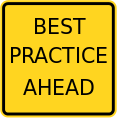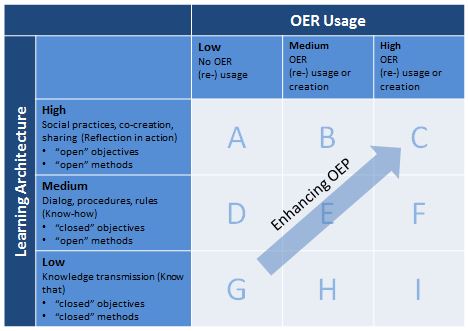Dimensions of openness in education/Open educational practices/OEP in context
In this section we review the definition of OER and describe the concept of OEP.
Contents
Defining OER
The term Open Educational Resources (OER) is gaining wider acceptance in higher education. As a reminder, review the following definition:
In short, there is general consensus that OER must meet two requirements:
- OER should be available at no-cost to the user and
- OER must ensure the legal permissions to engage in the 5Rs, that is to: reuse, revise, remix, redistribute and to retain a copy.
OER is more than just resources
While there exist plenty of OER repositories and OERs, universities are slow to adopt these resources. A number of organisations and initiatives have suggested that OER are more than just resources, using the concept of OEP to include practices that will facilitate adoption and uptake of OER. Consider the following descriptions:Cape Town Open Education Declaration
- In this declaration, you will find the following perspective, which incorporates technologies, teaching and learning approaches:
| “ | Open education is not limited to just open educational resources. It also draws upon open technologies that facilitate collaborative, flexible learning and the open sharing of teaching practices that empower educators to benefit from the best ideas of their colleagues. It may also grow to include new approaches to assessment, accreditation and collaborative learning. Understanding and embracing innovations like these is critical to the long term vision of this movement. | ” |
The International Council for Open and Distance Education (ICDE)
| “ | Open Educational Practices (OEP) are defined as practices which support the production, use and reuse of high quality open educational resources (OER) through institutional policies, which promote innovative pedagogical models, and respect and empower learners as co-producers on their lifelong learning path. OEP address the whole OER governance community: policy makers, managers and administrators of organizations, educational professionals and learners. | ” |
| —ICDE | ||
Center for Open Learning and Teaching (COLT), University of Mississippi
- COLT offers a different perspective focusing on teaching approaches:
| “ | Open Educational Practices (OEP) are teaching techniques that introduce students to online peer production communities. Such communities (for instance, Wikipedia, YouTube, Open Street Map) host dynamic communities and offer rich learning environments. | ” |
OPAL, the Open Educational Quality Initiative was formed to address this issue. Speaking in a very general way, they concluded that OERs could only be adopted if plans for OER adoption took into consideration policy, research, and educational practices of instructors and learners (Conole, chapter 7). In other words, OER alone are insufficient for providing open education; they must fit into Open Educational practices at the individual, institutional and national levels. The meaning of the term "Open Educational Practices" has been briefly alluded to. Let's take a clsoer look at this term using a few different definitions.
In the UKOER Synthesis and Evaluation project, OEP are seen as all activities that open up access to educational opportunity, in a context where freely available online content and services (whether 'open', 'educational' or not) are taken as the norm. Source: https://oersynth.pbworks.com/w/page/51685003/OpenPracticesWhat.
For the purpose of this course, we will aknowledge the above definitions while taking the view of OPAL which subtly includes learners, instructors and managers of higher education institutions. According to OPAL:
“Open Educational Practices (OEP) constitute the range of practices around the creation, use and management of open educational resources with the intent to improve quality and innovate education.”
Source: OEP Guide Guidelines for Open Educational Practices in Organizations (Vs. 2011)
To elaborate, Open Educational Practices make up the infrastructure and mindset needed to make the most of OERs. As an analogy, imagine that you had a car which represent OERs. Suppose there were no transportation laws, no roads, no road maps, no driving courses, and no mechanics. There would just be car manufacturers and distrubtors, and you and a lot of other people with cars. In such a situation, you can select from a large number of cars and you can drive a bit, but it's hard to get far comfortably and safely. That is how it is to use OERs without Open Educational Practices. There are a large number of OER repositories currently on the Internet, and this is already a great achievement. However there aren't a lot of institutions that have implemented OEPs. This means that instructors are often left to their own devices when using OERs. The instructors may very well use OERs effectively, but their job would be made much easier, and their courses could be of higher quality with support and clear regulations.
Upon reexaminig OPAl's definition, you might ask what kind of practices constitute OEP. The range can be vast, so for the purposes of this course, the scope of OEP will be limited to:
- Open scholarship
- Open policy
- Open source software
- Open teaching
References
- ↑ OER Defined, William and Flora Hewlett Foundation website.
Barriers to using OERs
An analysis of 60 OER initiatives by OPAL revealed that individuals are faced with five main barriers when they want to use OER: lack of institutional support; lack of technological tools for sharing and adapting resources; lack of users‘ skills and time; lack of quality or fitness of the resources; and personal issues such as lack of trust and time (2011) (Beyond OER).
Meanwhile, other studies (Thakrar, Zinn, Wolfenden, 2009; Butcher, 2010; as cited in Conole, 2012) revealed several success factors for OER integration:
- Social factors - aspects such as understanding the benefits of OER (understanding by government leaders, policy makers, organisational leaders and practitioners), being willing to share, contribute and open up, and seeking quality education and ethical behavior.
- Policy and enabling environment - this includes issues such as management, sustainability, funding models, and support.
- Skills and support - development of specific and related skills to find, use, repurpose and reuse OER, and the environment that support these activities.
- Technical aspects - lack of access to technologies such as broadband and other technological innovations, and insufficient interoperability to fully exploit OER. [1]
To focus in on funding models, read link title this article by Butcher & Hoosen (2012) [2]. It begins by explaining the value of OER in education and goes on to discuss profitable methods to use in different aspects of open education such as course design and development using OER, OER and textbook publishing, open access publishing, and OER and accreditation.
Activity based on this article???
Maturity Matrix
The first step in making institutional changes is to do an assessment to determine in which ways the institution is already working in an "open" way. Is everyone, including the learners, unaware of OEP? At the other extreme, is the institution on track to being a leader and innovator in OEP implementation? The diagram below serves to indicate different kinds and levels of openness as a function of the "Learning Architecture" and OER usage. Learning architecture refers to methods of teaching resulting from an infrastructure set up for a style of knowledge transmission. For example, traditional universities might use the style of teaching that relies on transmission from the instructor to the student. In contrast, ther are universities that have open education policies, and consequently contain centres and staff for offering training in open educational methods and technology use. This kind of university allows for instructors to deliver courses in ways that are compatible with open education.
To interpret the matrix, compare fields "H" and "B". Field "H" corresponds to an instructor who might use OERs in transmission-style lectures, while field "B" corresponds to an instructor who has been trained and provided with support and resources such that she delivers courses in an "open" style.
To go more into detail, we will examine the criteria on the left side of the table
“High” degrees of freedom and openness in pedagogical models are represented if objectives of learning as well as methods (e.g. learning pathways) are highly determined and governed by learners. Questions or problems around which learning is ensuing are determined by learners (SRL – self-regulated learners 6), and teachers facilitate through open and experience-oriented methods which accommodate different learning pathways, either through scaffolding and tutorial interactions (ZPD Vygotskian inspired approaches) or contingency tutoring (Woods & Woods strategies of re-enforcement, domain or temporal contingency).
“Medium” represents a stage in which objectives are still pre-determined and given, but methods of teaching and learning are represented as open pedagogical models. They encourage dialogue-oriented forms of learning or problem-based learning (PBL) focusing on dealing with developing “Know-how”.
"Low” if objectives as well as methods of learning and/ or teaching are rooted in “closed” one-way, transmissive and reproductive approaches to teaching and learning. In these contexts, the underlying belief is that teachers know what learners have to learn and mainly focus on knowledge transfer.
Source: OEP Guide http://oerworkshop.pbworks.com/w/file/fetch/44605120/OPAL-OEP-guidelines.pdf
To help you to situate your organization on the Maturity Matrix, ask yourself the following questions. Refer to the table at "Step 1" page 6 of the OEP guide to better answer these questions.
- To what extent are you using and repurposing OER in your organization?
- Do you have a process for creating OER in your organization?
- To what extent are you sharing OER and open educational practices in your organization?
- To what extent is your organization working with open learning architectures?
The next step is to create a vision and a plan for OEP across the institution followed by implementation and promotion of OEP.
Page 3: Who should be involved?
This part may needs its own page.
Policy makers
Policy makers are those who make decisions regarding educational issues in higher education and adult learning institutions such as governements, rectors, and deans. When higher education policy makers spend public funds, it follows that the educational materials should be made available with open licesnses (UNESCO & COL, 2011). In turn, universities can benefit from cost savings and increased quality when the propoer policies are in place for the use of OERs.
- Support the use of OER through their policy-making role in higher education.
- Consider adopting open licensing frameworks.
- Consider adopting open standards for sharing and using resources
- Contribute to raising awareness of key OER issues.
- Promote national ICT/connectivity strategies.
- Support the sustainable development and sharing of quality
learning materials.
Source: [3]
Institutional leaders
The role of institutional leaders in implementing OEPs is to provide support to instructors and students by allowing them to use OERs; providing technoligcal resources and support; providing training in the design, re-use, and sharing of OERs; providing training and promoting research on educational approaches; and giving incentives for using OERs and taking training in educational approaches.
When the result of these actions is to produce courses and educational research articles of consistently high quality that are made available to the public, institutions can improve their reputation and attract more funding and students.
With this in mind, specific actions that institutional leaders can take are to:
- Develop institutional strategies for the integration of OER.
- Provide incentives to support investment in the development, acquisition and adaptation of high quality learning materials.
- Recognise the important role of educational resources within internal quality assurance processes.
- Consider creating flexible copyright policies.
- Undertake institutional advocacy and capacity building.
- Ensure ICT access for staff and students.
- Develop institutional policies and practices to store and access OER.
- Review institutional OER practices periodically.
Source: [4]
Instructors
University instructors usually prepare the content they teach in courses, which is difficult if they also have research to do and funding to apply for. They have the added challenge of continously increasing class sizes, and the need to learn new educational techniques while most likely not having any basic training in pedagogy/andragogy. COurse design and course are mainly the responsibility of the instructor. COnsequently, their skill set greatly impacts the courses they produce and possibly share as OERs.
To get from the current approaches to course design and delivery to proper implementation of OEPs, instructors will need to:
- Develop skills to evaluate OER.
- Consider publishing OER.
- Assemble, adapt and contextualise existing OER.
- Develop the habit of working in teams.
- Seek institutional support for OER skills development.
- Leverage networks and communities of practice.
- Encourage student participation.
- Promote OER through publishing about OER.
- Provide feedback about, and data on the use of, existing OER.
- Update knowledge of IPR, copyright, and privacy policies.
Source: [5]
Learners
Learners today face an uncertain future and need to be well prepared for life after university. Employment and entrepreneurship is likely to involve the use of ICTs in a knowledge-based economy. As such, their investment in higher education needs to pay off, and needs to involve skills development in technology. Learners can see their cost of education reduced with the use of OERs, and they can obtain training in technology using open materials. To increase the likelihood of benefitting in these ways from OERs, learners need to advocate for OER use.
To do so, they should:
- Understand the issues of OER and undertake advocacy of OER.
- Encourage their members to publish work as OER.
- Take an active role in assuring the quality of OER through social networks.
- Recognise that ICT are an increasingly important part of the higher education experience and are often crucial for students with special educational needs.
- Encourage student participation in activities to support OER development.
Source: [6]
Page 4: Background of OPAL
The Open Educational Quality (OPAL) Initiative was established for the purpose of devising methods (which would turn out to be called OEPs) for having OERs adopted and used in higher education, and sensitizing stakeholders about these methods. The idea was to get institutions to value OEPs along with OERs (Conole, Chapter 7: Integrating OER into Open Educational Practices). OPAL was a two-year project which ran 2010-2011 and focused on the provision of innovative Open Educational Practices and the promotion of quality, innovation and transparency in higher and adult education. Reference: http://www.icde.org/ICDE+to+play+key+role+in+Open+Educational+Quality+Initiative.9UFRzW5W.ips
OPAL analyzed 60 OER initiatives worldwide to determine, among other things, the barriers and success factors in implementing OERs so that they could write recommendations and develop methods for facilitating adoption of OERs in a manner that univerisities could maintain high-quality programs.
OPAL was a consortium of several organisations listed in the table below.
| Organisation | Abbreviation | Country |
|---|---|---|
| International Council for Open and Distance Education | ICDE | Norway |
| United Nations Educational, Scientific and Cultural Organisation | UNESCO | France |
| Open University | OU | UK |
| European Foundation for Quality in E-Learning | EFQUEL | Belgium |
| Aalto University | AALTO | Finland |
| Universidade Católica Portugesa | UCP | PT |
| University Duisburg-Essen | UCP | Denmark |
|
Note: Adapted from Camilleri & Ehlers (2011)[7] | ||
Considering the role that OPAL played in the development of OEP, many of their documents have been selected as source material for this mini-course.
References
- ↑ Conole, G. (2012). Integrating OER into pen educational practices. In J. Glennie, K. Harley, N. Butcher, T. van Wyk (Eds.) Open educational resources and change in Higher Education: Reflections from practice, pp. 111-124. COL, UNESCO
- ↑ Butcher, N., & Hoosen, S. (2012). Exploring the business case for Open Educational Resources.
- ↑ United Nations Educational, Scientific and Cultural Organization Commonwealth of Learning (UNESCO & COL). (2011). Guidelines for Open Educational Resources (OER) in Higher Education. Retrieved from: http://www.col.org/PublicationDocuments/Guidelines_OER_HE.pdf
- ↑ United Nations Educational, Scientific and Cultural Organization Commonwealth of Learning (UNESCO & COL). (2011). Guidelines for Open Educational Resources (OER) in Higher Education. Retrieved from: http://www.col.org/PublicationDocuments/Guidelines_OER_HE.pdf
- ↑ United Nations Educational, Scientific and Cultural Organization Commonwealth of Learning (UNESCO & COL). (2011). Guidelines for Open Educational Resources (OER) in Higher Education. Retrieved from: http://www.col.org/PublicationDocuments/Guidelines_OER_HE.pdf
- ↑ United Nations Educational, Scientific and Cultural Organization Commonwealth of Learning (UNESCO & COL). (2011). Guidelines for Open Educational Resources (OER) in Higher Education. Retrieved from: http://www.col.org/PublicationDocuments/Guidelines_OER_HE.pdf
- ↑ Camilleri, A. F., Ehlers, U-D. (2011). Mainstreaming open educational practice: Recommendations for policy. EFQUEL. Retrieved from: [1]


